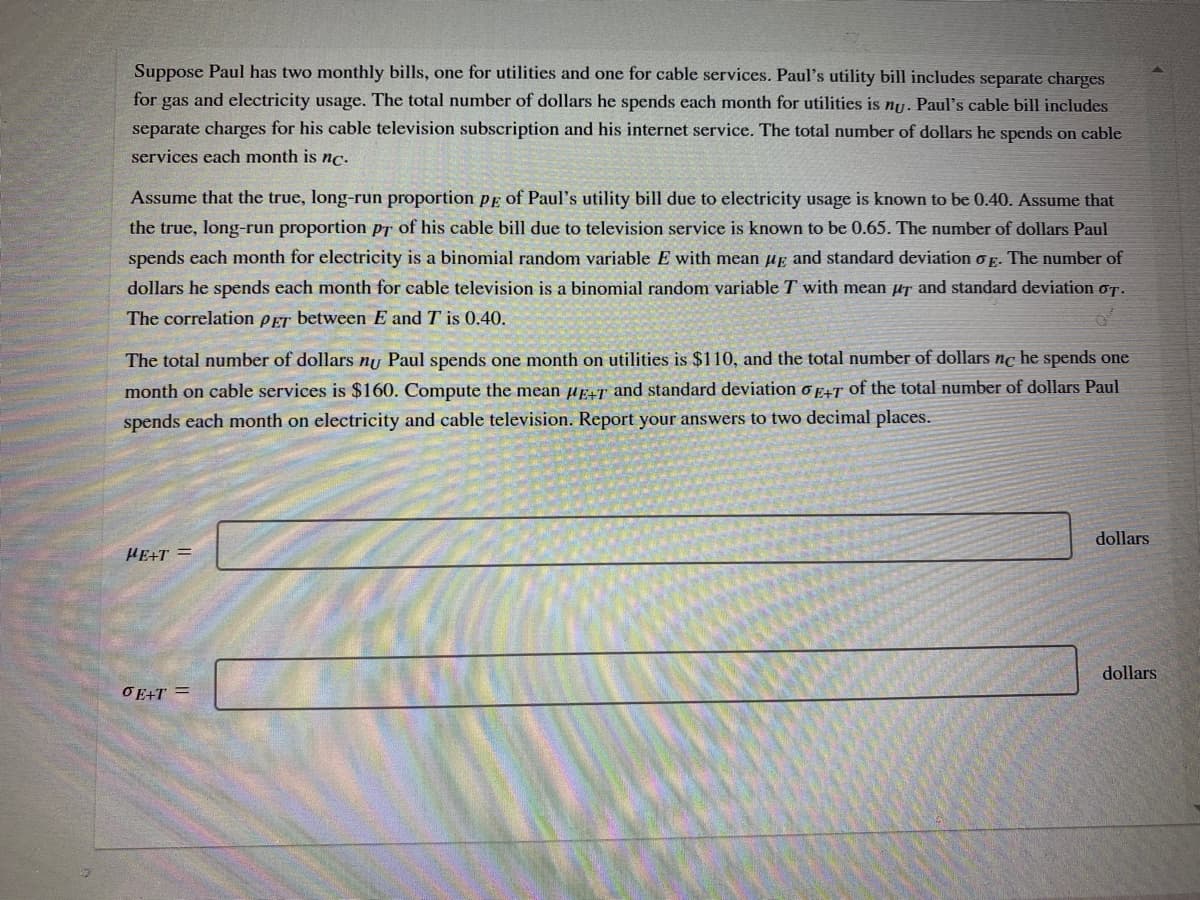Suppose Paul has two monthly bills, one for utilities and one for cable services. Paul's utility bill includes separate charges for gas and electricity usage. The total number of dollars he spends each month for utilities is nu. Paul's cable bill includes separate charges for his cable television subscription and his internet service. The total number of dollars he spends on cable services each month is nc. Assume that the true, long-run proportion pE of Paul's utility bill due to electricity usage is known to be 0.40. Assume that the true, long-run proportion Pr of his cable bill due to television service is known to be 0.65. The number of dollars Paul spends each month for electricity is a binomial random variable E with mean ug and standard deviation o E. The number of dollars he spends each month for cable television is a binomial random variable T with mean µr and standard deviation oT. The correlation PET between E and T is 0.40. The total number of dollars ny Paul spends one month on utilities is $110, and the total number of dollars nc he spends one month on cable services is $160. Compute the mean urAT and standard deviation o F4T of the total number of dollars Paul spends each month on electricity and cable television. Report your answers to two decimal places. dollars HE+T = dollars O E+T =
Suppose Paul has two monthly bills, one for utilities and one for cable services. Paul's utility bill includes separate charges for gas and electricity usage. The total number of dollars he spends each month for utilities is nu. Paul's cable bill includes separate charges for his cable television subscription and his internet service. The total number of dollars he spends on cable services each month is nc. Assume that the true, long-run proportion pE of Paul's utility bill due to electricity usage is known to be 0.40. Assume that the true, long-run proportion Pr of his cable bill due to television service is known to be 0.65. The number of dollars Paul spends each month for electricity is a binomial random variable E with mean ug and standard deviation o E. The number of dollars he spends each month for cable television is a binomial random variable T with mean µr and standard deviation oT. The correlation PET between E and T is 0.40. The total number of dollars ny Paul spends one month on utilities is $110, and the total number of dollars nc he spends one month on cable services is $160. Compute the mean urAT and standard deviation o F4T of the total number of dollars Paul spends each month on electricity and cable television. Report your answers to two decimal places. dollars HE+T = dollars O E+T =
Algebra: Structure And Method, Book 1
(REV)00th Edition
ISBN:9780395977224
Author:Richard G. Brown, Mary P. Dolciani, Robert H. Sorgenfrey, William L. Cole
Publisher:Richard G. Brown, Mary P. Dolciani, Robert H. Sorgenfrey, William L. Cole
Chapter7: Applying Fractions
Section7.1: Ratios
Problem 25WE
Related questions
Question

Transcribed Image Text:Suppose Paul has two monthly bills, one for utilities and one for cable services. Paul's utility bill includes separate charges
for gas and electricity usage. The total number of dollars he spends each month for utilities is nu. Paul's cable bill includes
separate charges for his cable television subscription and his internet service. The total number of dollars he spends on cable
services each month is nc.
Assume that the true, long-run proportion pE of Paul's utility bill due to electricity usage is known to be 0.40. Assume that
the true, long-run proportion ps of his cable bill due to television service is known to be 0.65. The number of dollars Paul
spends each month for electricity is a binomial random variable E with mean ug and standard deviation o E. The number of
dollars he spends each month for cable television is a binomial random variable T with mean µs and standard deviation oT.
The correlation pET between E and T is 0.40.
The total number of dollars ny Paul spends one month on utilities is $110, and the total number of dollars nc he spends one
month on cable services is $160. Compute the mean up+T and standard deviation o p+T of the total number of dollars Paul
spends each month on electricity and cable television. Report your answers to two decimal places.
dollars
HE+T =
dollars
OE+T =
Expert Solution
This question has been solved!
Explore an expertly crafted, step-by-step solution for a thorough understanding of key concepts.
This is a popular solution!
Trending now
This is a popular solution!
Step by step
Solved in 3 steps with 2 images

Recommended textbooks for you

Algebra: Structure And Method, Book 1
Algebra
ISBN:
9780395977224
Author:
Richard G. Brown, Mary P. Dolciani, Robert H. Sorgenfrey, William L. Cole
Publisher:
McDougal Littell

Elementary Geometry For College Students, 7e
Geometry
ISBN:
9781337614085
Author:
Alexander, Daniel C.; Koeberlein, Geralyn M.
Publisher:
Cengage,


Algebra: Structure And Method, Book 1
Algebra
ISBN:
9780395977224
Author:
Richard G. Brown, Mary P. Dolciani, Robert H. Sorgenfrey, William L. Cole
Publisher:
McDougal Littell

Elementary Geometry For College Students, 7e
Geometry
ISBN:
9781337614085
Author:
Alexander, Daniel C.; Koeberlein, Geralyn M.
Publisher:
Cengage,


Holt Mcdougal Larson Pre-algebra: Student Edition…
Algebra
ISBN:
9780547587776
Author:
HOLT MCDOUGAL
Publisher:
HOLT MCDOUGAL